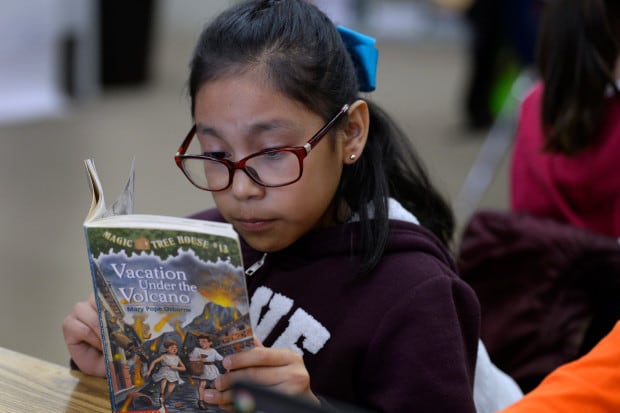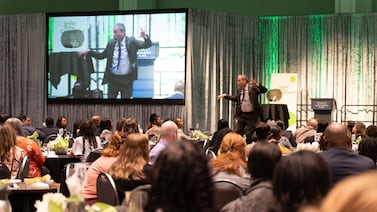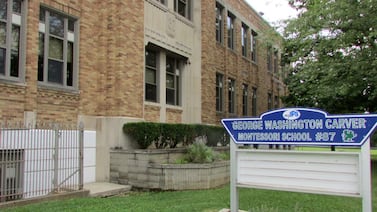When schools closed in March to fight the spread of the coronavirus, educators in the 27J district north of Denver made a decision. Knowing that not all students could access online lessons, educators decided not to teach new material.
Now, as they plan for an uncertain fall, educators aren’t overly worried about learning loss or how they’ll catch students up to grade level. They say the time spent going over basics while teachers worked out the kinks of remote learning helped students who were already behind.
“We didn’t want to leave kids behind, we wanted to focus on welfare checks and on helping students retain what they had already learned,” said Kathey Ruybal, the president of the teachers union in 27J. “By doing that pause we were able to really do a needs assessment. Now, we have a better idea of what our community needs.”
Teachers called families every week. Most still held live, if remote, classes. Some scheduled their students into small groups for lessons where they went over material students hadn’t mastered yet, and paper packets of work were available for students who needed it.
Third-grade teacher Barbara Haggerty said parents appreciated the district’s approach. “We were able to intervene,” Haggerty said. “We would say, ‘this family doesn’t have a Chromebook; let’s go drop one off.’”
More than 3,000 Chromebooks were distributed to students in the district during the shutdown.
Haggerty, who works at Pennock Elementary, saw her students master material during remote learning.
“They were all working on their level, it was so differentiated,” Haggerty said. “I feel very confident they’re all going to know all of these things that my grade-level kids certainly had already mastered.”
Each morning, Haggerty’s students sang their morning song, and then had a brief game to start the day. Then Haggerty would tell them what math, reading and writing assignments they should work on that day online, and would suggest some extra “learning opportunities” like virtual field trips they could take that day.
At 3 p.m. the class would reconvene on a video call for Haggerty to read a story, and so each student could see how many points they got for the day.
One thing she would change, if she had to do it again, would be to incorporate more hands-on activities. Some national experts have cautioned teachers not to ask students to do activities that required materials some may not have at home, but Haggerty said she would like to be able to prepare a take-home bag for students that could include a book, scissors, and dice for math activities.
While educators in 27J hope for more opportunities to teach students in their classrooms, these are the types of lessons they would apply to offer high-quality remote learning if that’s what’s necessary.
Some remote learning continues to be a possibility for the next school year across the state. The 27J district is working on addressing more equity concerns. The district is buying more devices for students and has set aside roughly $415,000 from federal coronavirus relief dollars to pay for home internet for about 2,000 students.
Teachers and district officials are confident that they will be ready to reach all students if they have to do remote learning again.
“We learned a ton of lessons and we created some solutions. We’re ready,” said Will Pierce, chief academic officer for the district. But, he added, “The best place for kids is school and we would open it up to all of them if we could.”
While the current situation and 27J’s approach are unprecedented, various studies of student absences, summer learning loss, and lengthy school closures show that losing time in school can set students back academically, and although some experts believe remote learning might soften those impacts, research doesn’t show online learning as promising.
The 27J school district made national headlines in 2018 as the first in the metro area to move all schools to a four-day school week. It serves more than 19,000 students of which 56% are students of color, and 35% qualify for subsidized lunches.
Pierce said a survey of parents showed that 83% of those who responded said they want to have their children back in school face-to-face with their teachers this fall.
While the district hasn’t yet committed to a final plan, officials are preparing to allow most students back to school, as state officials suggest they might allow.
That would relieve one concern Pierce still had about this fall: how teachers would administer assessments virtually.
“It would be a challenge,” Pierce said. “We would love to do that face to face.”
While the assessments are critical so the district can figure out if students fell far behind, and so that teachers can help target instruction to get students back on track, district educators don’t expect that results would show anything too abnormal from typical summer gaps.
Much of April is spent on testing and not learning new material, some said. And teachers’ curricular plans already build in time during the fall to review previous material students might forget over the summer.
Pierce said that the district is prepared to offer tutoring or additional instructional time for students who may be farther behind.
Teachers also want the district to be aware that students coming back to schools will have a lot of needs for mental health support to process these last few months.
Brittany Atkerson, another elementary teacher in 27J, said she learned this spring that students need more lessons on internet safety as they spend more time online. She spent much of the first weeks helping students learn how to access resources.
She also wants any fall plan to focus on creating opportunities for students, especially those in elementary grades, to interact socially with their peers. Much of elementary school is about learning coping and interaction skills, she said.
“We have to make sure we are providing those opportunities,” Atkerson said.
Some ideas she has, in case school had to start remotely, is to have students write to each other as pen pals, setting up time for parents to meet with her virtually, and playing games during virtual time together.
Pierce said that regardless of the final plan for fall, teachers are involved at each school in helping design what the fall should look like. And they’re all talking about equity issues.
“It’s a great thing for us to have a greater recognition of the inequities and the invisible barriers that exist for families,” Pierce said. “We should have known all along but that’s been very powerful to see.”







